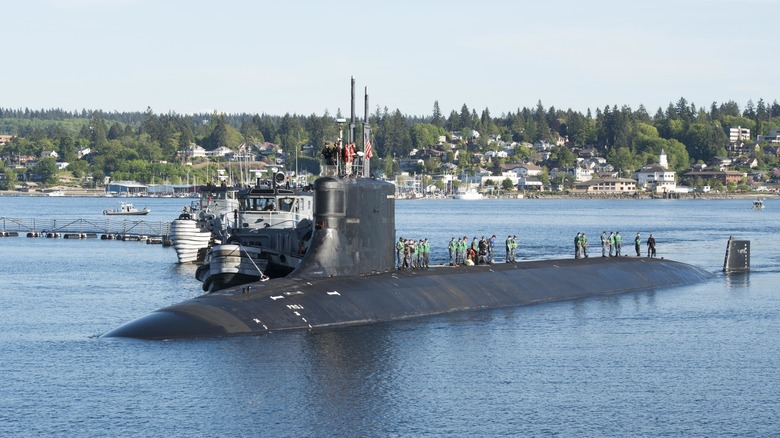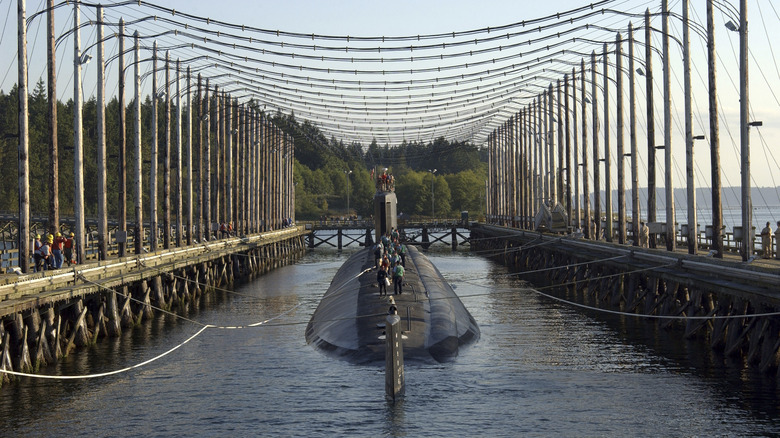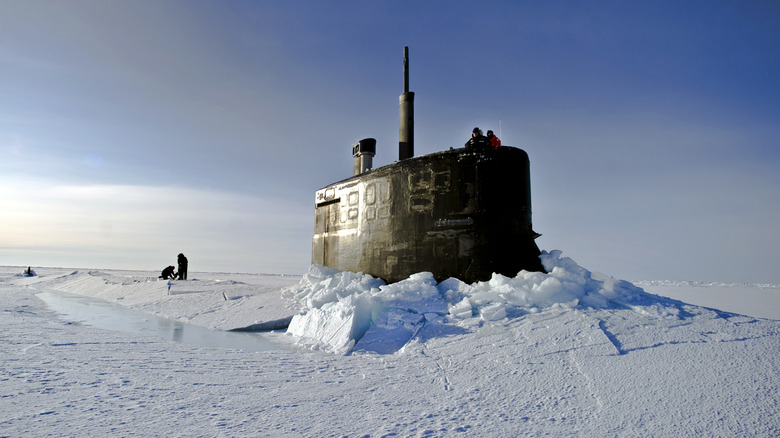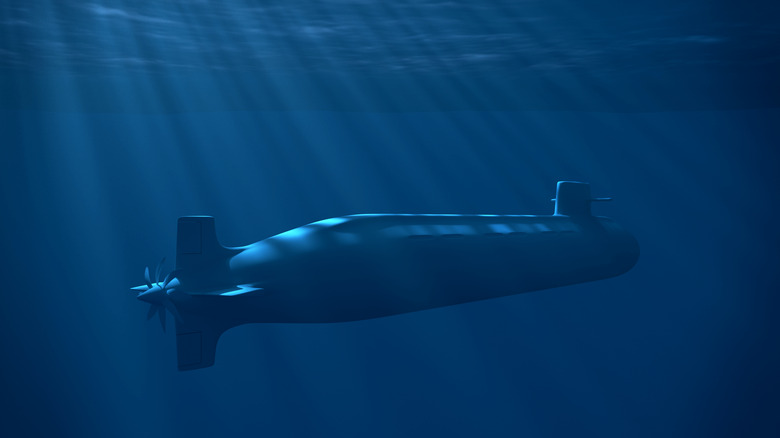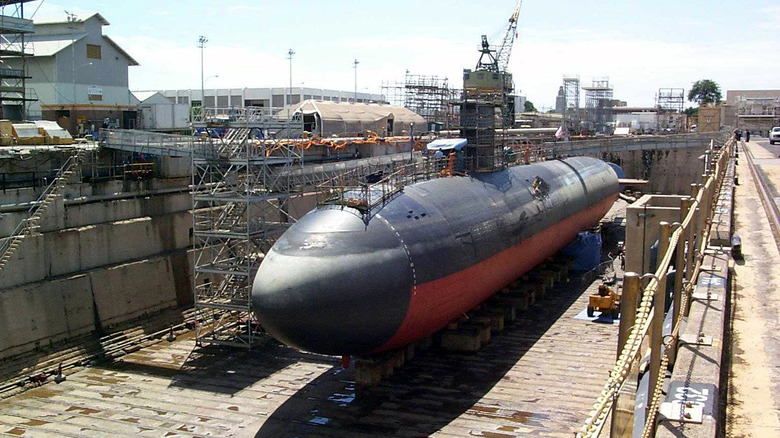Which Seawolf-Class Submarine Hit An Underwater Mountain? Here's What You Need To Know
The U.S. Navy's fleet of submarines might be large, but it only has three Seawolf-class attack submarines: The USS Seawolf (SSN 21), the USS Connecticut (SSN 22), and the USS Jimmy Carter (SSN 23). These are some of the most advanced attack submarines in America's fleet, second only to the newer Virginia-class subs. As advanced as they are, they're only as good as their crew and, sadly, there are sometimes mistakes. They are, after all, only human. In 2021, the USS Connecticut struck an undersea object in international waters in the South China Sea that took the vessel out of action. The Connecticut was forced to surface and sail to Guam, which took a week.
At first, Chinese officials felt the U.S. Navy was covering up details of the incident, but even they were confused about how such an event could happen. China was understandably upset as the incident took place close to its submarine base on Hainan Island, known for being one of the most sophisticated naval facilities in the world. However, it's unlikely that the submarine was spying on the Chinese — something officials were implying — because if it was, the Navy wouldn't have made a public announcement, drawing attention to their activities.
That's not to say that the United States doesn't use submarines and other methods to gather intelligence on its rivals, but it's more likely the Navy would have used the USS Jimmy Carter (SSN 23) for such a mission, as it's a modified Seawolf designed for special operations. So, what exactly happened to the USS Connecticut?
What is a Seawolf submarine?
America has three different classes of nuclear-powered attack submarines: The Los Angeles-class, Virginia-class, and Seawolf-class. The Navy intended to replace the aging Los Angeles-class with Seawolf subs, but due to a combination of costs and shifts in submarine goals, the U.S. Navy chose to build only three Seawolf submarines and instead focus on replacing the Los Angeles-class with the more advanced Virginia-class. Unlike its predecessor, Seawolf attack submarines don't have a Vertical Launch System. Instead, they have eight torpedo tubes and can hold up to 50 weapons in its torpedo room.
The Navy ordered the first Seawolf (SSN 21) in 1989, and it was commissioned in 1997. The second one, USS Connecticut (SSN 22) was commissioned in 1998, and the third one not until 2005. The third Seawolf, USS Jimmy Carter (SSN 23) is a special case as it received a 100-foot hull extension to improve its payload carrying capabilities. Other modifications it received improved its maneuverability, ballast control, and the ability to deploy and recover payloads without using torpedo tubes (known as the "wasp waist").
Submerged, the Seawolf subs can go as fast as 35 knots, but if it decreases its speed down to 20 knots, it becomes significantly harder for adversarial submarines to detect. These submarines, according to their manufacturer, General Dynamic Electric Boat, are "Less detectable at high speed than a Los Angeles-class submarine sitting at pier side." They can roughly travel as deep as 800 feet when they need to, where most hope to avoid underwater mountains.
What happened to the USS Connecticut?
Submarines running aground isn't unheard of. In 2002, the Los Angeles-class submarine USS Hartford (SSN 768) grounded itself when the navigation team failed to make appropriate calculations, suffering $9 billion worth of damage. It's a rare event, though. Between sonar, fathometers – a device that measures the depth of the water underneath the ship's keel — and satellite-generated maps, submarines have a good grasp on navigating the ocean's depths without running into any objects. In the USS Connecticut's case, the quartermaster took note of some discrepancies between the sub's charts and the depths at which they were traveling.
The quartermaster informed the officer of the deck (OOD) of the inconsistencies. While the OOD expressed his concern, he opted not to make adjustments to the ship's speed or route, nor did he inform the CO. Shortly before colliding with the seamount, the Sonar Supervisor got a reading that they classified as an animal, only to be caught off-guard and slam into an underwater mountain. All souls aboard were safe, save for minor injuries sustained by eleven crew members. Unfortunately, the whole even could have been prevented.
The crew probably shouldn't have been cleared to sail
The U.S. Navy's official report from the investigation into Connecticut's underwater collision says, "USS Connecticut grounded on an uncharted seamount while operating submerged in a poorly surveyed area in international waters in the Indo-Pacific region." It goes on to say that the collision could have been avoided, that "the grounding was preventable." That's not a good look for a submarine crew. It shows a lack of training, expertise, and overall failure of standards if true. In fact, the Navy knew the skipper was lacking in his leadership for some time and failed to do anything about it.
According to Forbes, after almost a year commanding the Connecticut, Commander Cameron Aljilani received what's called a "Letter of Performance" that said Aljilani exhibited "inadequate supervisory oversight, ineffective accountability practices, and superficial self-assessment." Seven months later, he received another letter for substandard performance. Under his command, the submarine collided with a pier and an investigation was initiated immediately. The investigator recommended disciplinary action for those responsible, including the commanding officer (CO) all the way down to the assistant navigator (ANAV), only for the Commander of Submarine Development Squadron-5 to ignore the recommendation.
Being in command of and operating a highly advanced fast attack submarine is no doubt a stressful career that requires long hours and rigorous training. While the bulk of the blame does fall at the feet of Aljilani, with multiple reprimands, it appears that the entire seamount incident could have been avoided had the somebody higher up stepped in.
What happened to the USS Connecticut since?
With significant damage to the sub after crashing into an underwater mountain — the bow and sonar dome were lost while the lower half of the rudder sustained damage, as well — the USS Connecticut is going to need some serious repairs. It first docked in Guam to get patched up enough to make the trip to San Diego, California. After San Diego, the sub made way for Puget Sound, Washington, where it could be placed into dry-dock and receive repairs. It made it into dry-dock on July 12, 2023, nearly two years after the South China Sea incident. The USS Connecticut was already scheduled for what's known as an Extended Dry-Docking Selected Restricted Availability (EDSRA), a process all submarines are subject to in their life cycle.
An EDSRA not only allows maintenance teams to repair all damage sustained from the October 2021 crash, but it also lets them upgrade the sub's hull and propulsion systems and anything else in need of modernization. Unfortunately, the USS Connecticut won't be back on active duty until 2026, after it has received $80 million worth of maintenance and repairs. While the Connecticut being out of commission sadly leaves only two other Seawolf-class submarines on active duty, they aren't the only attack subs in the Navy's fleet. It's unfortunate to have any submarine pulled from the lineup, but it's more embarrassing for everyone involved when the public learns why it was pulled.
